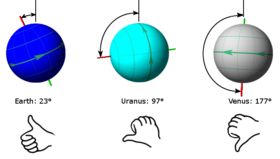Obliquity
|
|
|
The positive pole of a planet is defined by the right-hand rule: if the fingers of the right hand are curled in the direction of the rotation then the thumb points to the positive pole. The axial tilt is defined as the angle between the direction of the positive pole and the normal to the orbital plane. The angles for Earth, Uranus and Venus are approximately 23°, 97°, and 177° respectively. |
In astronomy, axial tilt, also known as obliquity, is the angle between an object's rotational axis and its orbital axis, or, equivalently, the angle between its equatorial plane and orbital plane. It differs from orbital inclination.
At an obliquity of zero, the two axes point in the same direction; i.e., the rotational axis is perpendicular to the orbital plane. Over the course of an orbit, the obliquity usually does not change considerably, and the orientation of the axis remains the same relative to the background stars. This causes one pole to be directed more toward the Sun on one side of the orbit, and the other pole on the other side — the cause of the seasons on the Earth. Earth's obliquity oscillates between 22.1 and 24.5 degrees on a 41,000-year cycle; the earth's mean obliquity is currently 23°26′13.5″ (or 23.43707°) and decreasing.
The positive pole of a planet is defined by the right-hand rule: if the fingers of the right hand are curled in the direction of the rotation then the thumb points to the positive pole. The axial tilt is defined as the angle between the direction of the positive pole and the normal to the orbital plane. The angles for Earth, Uranus and Venus are approximately 23°, 97°, and 177° respectively.
There are two standard methods of specifying tilt. The International Astronomical Union (IAU) defines the north pole of a planet as that which lies on Earth's north side of the invariable plane of the Solar System; under this system, Venus is tilted 3° and spins retrograde, opposite that of most of the other planets.
The IAU also uses the right-hand rule to define a positive pole for the purpose of determining orientation. Using this convention, Venus is tilted 177° ("upside down").
...
Wikipedia

